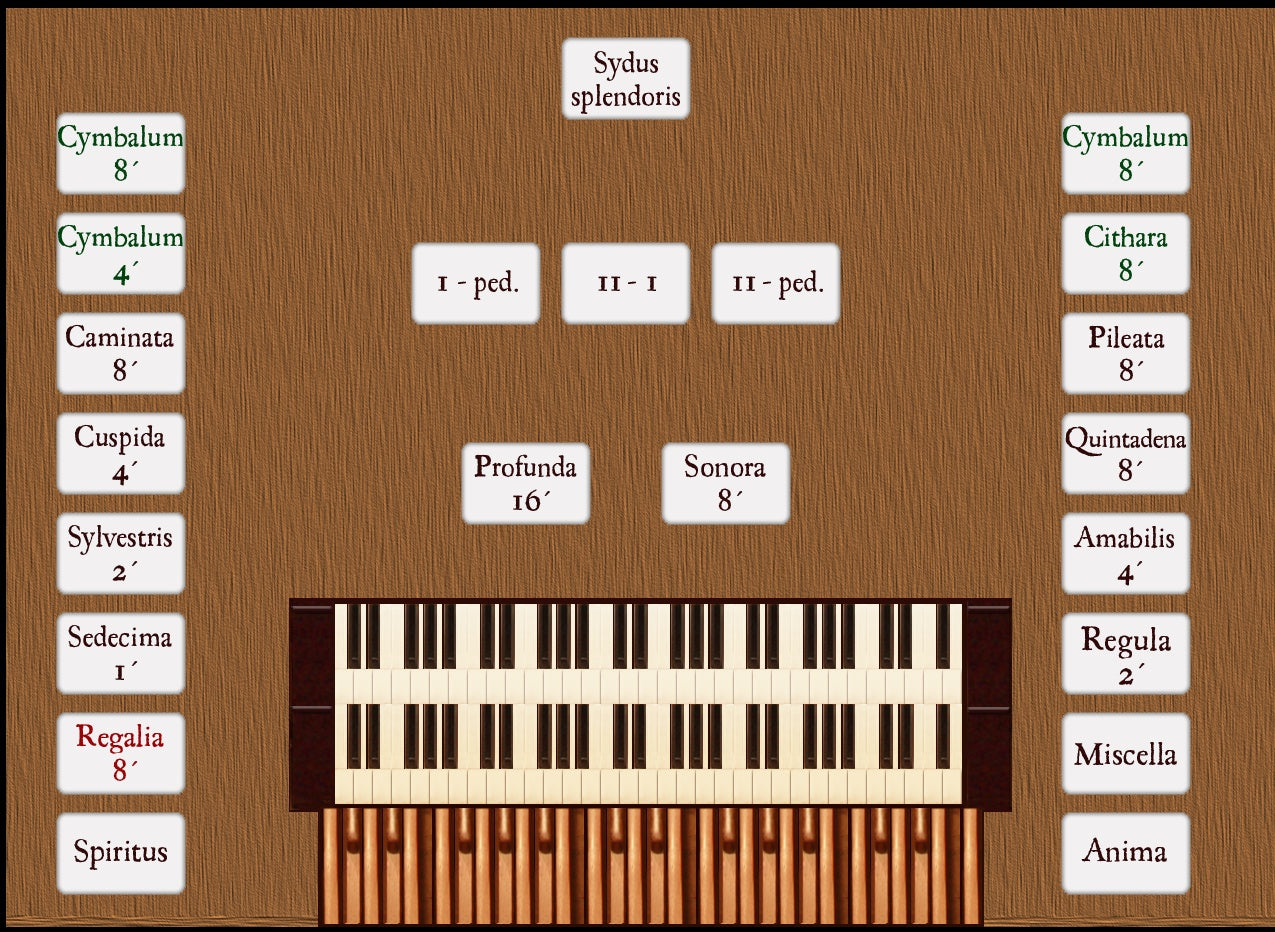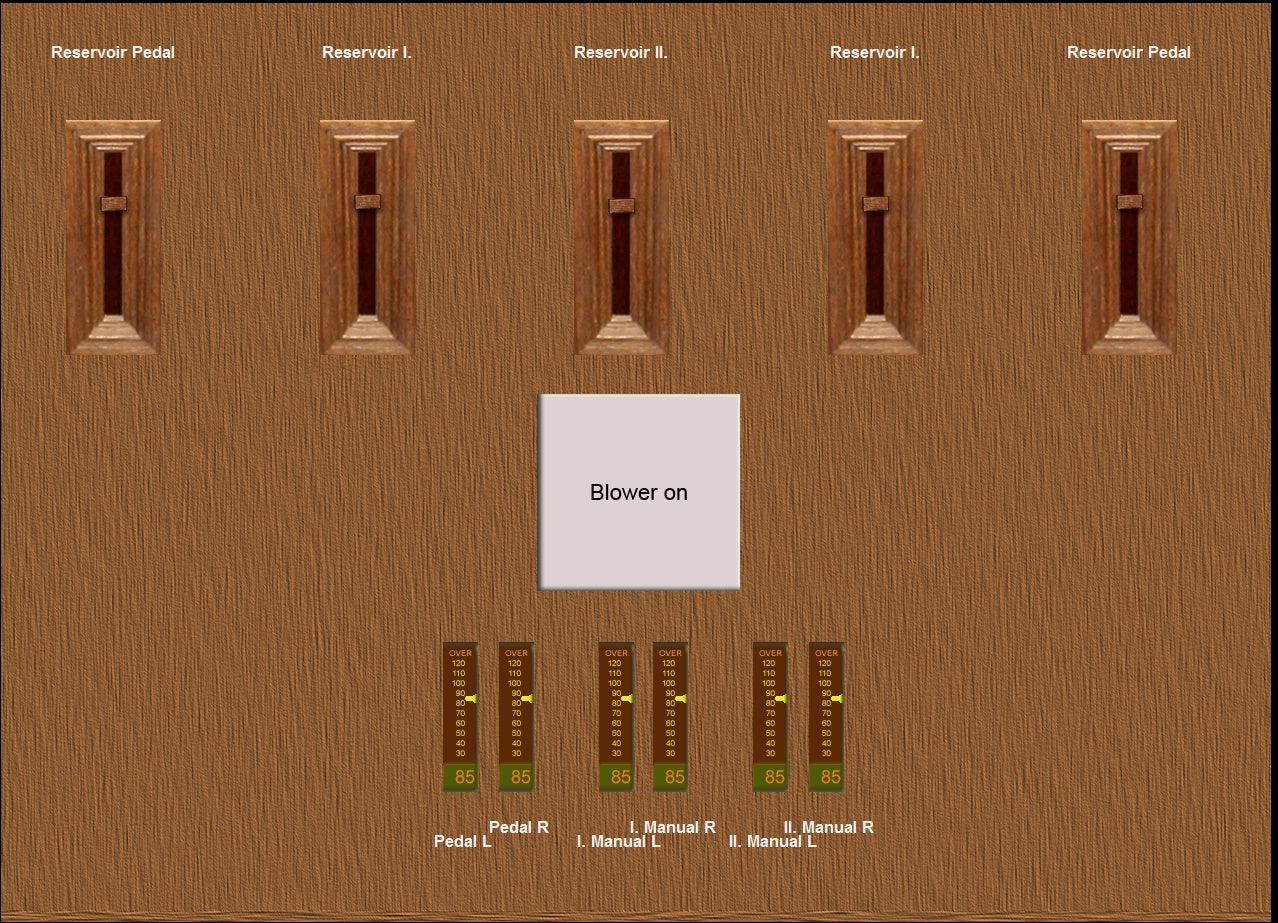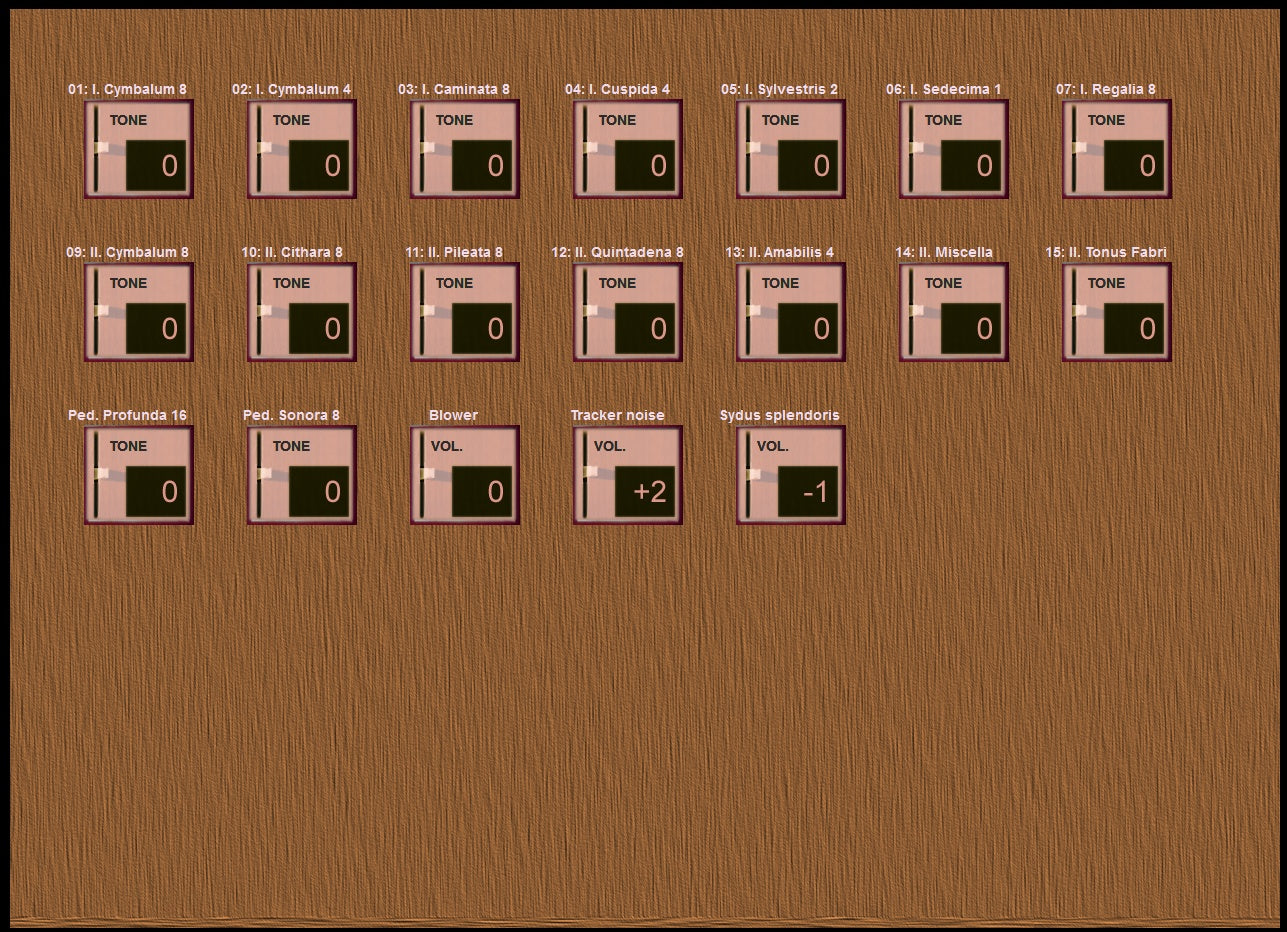Sonus Paradisi
Claviorganum Sonus Paradisi [Hauptwerk]
Claviorganum Sonus Paradisi [Hauptwerk]
Couldn't load pickup availability
Claviorgan, Claviorganum - a combination of a harpsichord and a chair-organ.
This Hauptwerk model is purely virtual, combining stops from several instruments recorded by Sonus Paradisi in the past. All together 16 speaking stops, plus a Zimbelstern. Nevertheless, the samples, as they are used in the claviorganum, are not to be found in any of the existing Sonus Paradisi sample sets.
The sample set uses two very special virtual stops Anima and Spiritus.
These stops do not sound at all, but they animate the instrument. They add a lot of wind consumption to the corresponding divisions, thus resulting in very lively wind pressure changes. It creates a nice effect of a wind shortage (wind sag), which is sometimes very characteristic of small chair organs.
The design of this virtual claviorganum is indeed unorthodox. However, there is clear idea behind this design. There are three instruments in one.
- The basis is a traditional claviorganum.
- However, this sample set is also a large two manual harpsichord on its own.
- Finally, this sample set is also a standalone continuo organ, to be used as a single manual chair organ with a soft pedal.
It is clear from this design, that the instrument was not intended to be used in a "tutti" manner.
Presented to you by Leonart Studio, your authorised reseller for Sonus Paradisi in Switzerland (shipped internationally). Get your digitally sampled historical organs for the use with the Hauptwerk virtual instrument software.
Share this Sample Set
![Claviorganum Sonus Paradisi [Hauptwerk]](http://artful.shop/cdn/shop/files/ss_claviorganum.jpg?v=1693273472&width=1445)
![Claviorganum Sonus Paradisi [Hauptwerk]](http://artful.shop/cdn/shop/files/ss_claviorganum11_7ca97837-187c-4b61-afc6-f373101c9ff8.jpg?v=1693273472&width=1445)
![Claviorganum Sonus Paradisi [Hauptwerk]](http://artful.shop/cdn/shop/files/ss_claviorganum12_5d9fc078-c967-4ccd-a984-a96285cc0f7a.jpg?v=1693273472&width=1445)
![Claviorganum Sonus Paradisi [Hauptwerk]](http://artful.shop/cdn/shop/files/ss_claviorganum13_1432a27e-2712-447d-a4dd-4909fd29abe3.jpg?v=1693273472&width=1445)
Specification (stop list)
-
Manual I
Harpsichord 8' Cymbalum
Harpsichord 4' Cymbalum
Rohrfloet 8' Caminata
Spitzfloet 4' Cuspida
Waldfloet 2' Sylvestris
Siffloet 1' Sedecima
Vox Humana 8 Regalia -
Manual II
Harpsichord 8' Cymbalum
Lute 8' Cithara
Gedackt 8' Pileata
Quintadena 8'
Gedackt 4' Amabilis
Principal 2' Regula
Cimbel 1' Miscella -
Manual III
-
-
Manual IV
-
-
Pedal
Pommer 16' Profunda
Portunal 8' Sonora -
Other specification
Zimbelstern Sydus splendoris
Usual couplers are available (I to Ped, II to Ped, II to I)
The sample set uses two very special virtual stops Anima and Spiritus.
These stops do not sound at all, but they animate the instrument. They add a lot of wind consumption to the corresponding divisions, thus resulting in very lively wind pressure changes. It creates a nice effect of a wind shortage (wind sag), which is sometimes very characteristic of small chair organs.
History
Claviorganum
Claviorgan, Claviorganum - a combination of a harpsichord and a chair-organ. History of this chamber instrument may be found in musical encyclopaedias (such as the New Grove) or on the internet - there is a Wiki article about the instrument available. A list of selected surviving claviorgana including their design and stop specification was supplied by dr. Stuart Frankel.
This Hauptwerk model is purely virtual, combining stops from several instruments recorded by Sonus Paradisi in past. Alltogether 16 speaking stops, plus a Zimbelstern. Nevertheless, the samples, as they are used in the claviorganum, are not to be found in any of the existing Sonus Paradisi sample sets.
The stop naming was chosen to be Latin, because of the exquisite and noble sounding of the language which couples perfectly with the refined and corteous sounding of the carefuly selected and for-the-purpose revoiced stops.
The sample set uses two very special virtual stops Anima and Spiritus.
These stops do not sound at all, but they animate the instrument. They add a lot of wind consumption to the corresponding divisions, thus resulting in very lively wind pressure changes. It creates a nice effect of a wind shortage (wind sag), which is sometimes very characteristic of small chair organs.
A beta tester reported:
What a delightful instrument! It is fair to make a virtual claviorganum, since most of the historical claviorgana are now virtual (that is: some surviving harpsichords look like they were part of a claviorganum in the past, but the organ has disappeared). A historical problem with your instrument is that the organ part is too big - all the historical instruments just had either a regal or a few flue stops built on a stopped 8'. But you know this, I'm sure. The Sonus Paradisi Claviorganum can be thought of as a library of possible claviorganum sounds. I have to congratulate you on this instrument.
Indeed, the idea behind this Sonus Paradisi project is very presicely expressed in his report. The sample set should be used as a bank of stops from which the user should select a subset suiting his needs.
The design of this virtual claviorganum is indeed unorthodox. However, there is clear idea behind this design. There are three instruments in one.
The basis is a traditional claviorganum: the organ stops placed on the lower manual (8' + 4' + 2' + 1' + reed), the harpsichord stops on the upper manual (8' + Lute).
However, this sample set is also a large two manual harpsichord on its own, hence the presence of the harpsichord stops on both the manuals: 8' + 4' on the lower, 8' + Lute on the upper.
Finally, this sample set is also a standalone continuo organ, to be used as a single manual chair organ with a soft pedal. To allow for a wider menu of the organ sound, there are additional organ stops on the second manual which may be used to complement, or better to substitute the stops on the lower manual. It is not a real two manual organ (although even such use is not excluded). Instead, the organist is invited to select just the one 8' stops from the three available according to the requirements of the music performed. Similarly, the user can select from two 4 feet stops, and from two different 2 feet stops.
It is clear from this design, that the instrument was not intended to be used in a "tutti" manner. Several examples of the use of the sample set are listed below.
A three stop small claviorganum may be obtained using the Cimbalum 8' solo on the low manual, and Quintadena (or Pileata, but not both together) plus the Amabilis on the upper.
Conversely, different claviorganum may be composed of the Regalia on the lower manual, and the Cimbalum and Cithara on the upper.
Larger claviorganum is obtained using the organ stops on the lower manual (8', 4', 2', 1', with or without the Regalia) and the harpsichord sounds from the upper.
A single keyboard claviorganum is obtained by using only the lower manual, not necessarily using all the organ stops, a selection of 8' + 4'+ reed, together with the harpsichord stops of the same keyboard would be appropriate. Alternatively, the same setting may be obtained from the upper manual solo (possibly omitting the cymbel stop).
A chair organ may be composed as follows: all organ stops from the lower (or upper) manual plus the pedal (16' or 8' or both). Additionally, the Miscella from the upper manual may be mixed in to complement the plenum.
The Zimbelstern is supplied especially for those who wish to use it standalone using a miniature mobile Hauptwerk installation and one little speaker, to complement a real pipe organ in their church.
Numerous other subsets are possible whenever needed. The sample set is best played from a dedicated hardware console without the use of the Hauptwerk screens (headless mode).
Features
The sample quality
The sample set is available in 44.1kHz sample rate and 16-bit resolution (the CD quality). The audio samples are 2 channel (stereo).
The sample set is completely dry. There is no reverberation inherent to the samples. The harpsichord samples seem to have a reverb, but that is the natural resonance of the instrument, not a room ambience.
No encryption used, plain wave format available.
Voicing features
Sonus Paradisi per stop voicing available - the possibility to change the tonal color of stops. This functionality is normally limited to the Hauptwerk Advanced version (on per pipe basis), the sliders used in the sample set allow for voicing (on per stop basis) even in in the Hauptwerk Basic version.
Concentration on versatility
The reason why Sonus Paradisi developed a hybrid instrument connecting harpsichord and an organ was our own need to have a universal continuo instrument for our portable MIDI console. We wanted it all in one, so that there is no need to switch between instruments during performance. Simply "plug and play", responding to the necessity of a universal, versatile and quick setup. For that reason, the idea of imitating some existing claviorgan seemed too narrow and the specification of a typical claviorgan too limited. We needed the organ part having a stand alone plenum, including the mixture to be usable during masses and similar church celebrations as a substitute for a real church organ. At the same time, we needed a versatile chamber music instrument for the accompaniment of soloists.
We opted for a rich organ specification split on two manuals and for a large two manual harpsichord. Nevertheless, to use 4 manuals for such a hybrid instrument would be probably too much for a good taste. Therefore, the design was based on the two manual organ and the two manual harpsichord merged together. Such design is clear and easy to understand and equally easy to handle. The obvious objection is, that there was never a claviorganum of this type really existing. Well, this creation is purely virtual, then. Those who need the organ and the harpsichord part split apart to allow for rapid switching between the two instruments, these users can find their way by using the Hauptwerk native combination system. Switching between the full organ and the full harpsichord is then as easy as pressing one button (or a foot piston).
The instrument is devised for live performance in churches, concert halls and similar places with enough reverberation to blend the dry samples smoothly. For home use, it is good idea to add some little reverberation.




Requirements
The RAM consumption when loaded
24-bit: 2.6 GB
20-bit: 2.16 GB (recommended)
16-bit: 1.41 GB
This Hauptwerk Sample Set is presented to you by Leonart Studio, an authorised reseller for the manufacturer Sonus Paradisi in Switzerland (shipping internationally). Enjoy this digitally sampled organ library for the use with Hauptwerk software and start expanding your historical organ collection today.
More Hauptwerk Sample Sets
-
Casavant, 1995 [Hauptwerk]
Vendor:Sonus ParadisiRegular price CHF 174.90Regular priceUnit price / per -
Bückeburg, 1997 [Hauptwerk]
Vendor:Sonus ParadisiRegular price From CHF 1.10Regular priceUnit price / per -
Schwerin, Dom, Ladegast Organ 1871 [Hauptwerk]
Vendor:Sonus ParadisiRegular price CHF 616.00Regular priceUnit price / per -
Segovia, 1772 [Hauptwerk]
Vendor:Sonus ParadisiRegular price CHF 317.90Regular priceUnit price / per -
Reuter, 1928 [Hauptwerk]
Vendor:Sonus ParadisiRegular price CHF 473.00Regular priceUnit price / per -
Rotterdam Hoofdorgel, 1973 [Hauptwerk]
Vendor:Sonus ParadisiRegular price From CHF 330.00Regular priceUnit price / perCHF 958.10Sale price From CHF 330.00Sale -
Groningen, 1450-1740 [Hauptwerk]
Vendor:Sonus ParadisiRegular price From CHF 658.90Regular priceUnit price / perCHF 1,681.90Sale price From CHF 658.90Sale -
Frankfurt a.d. Oder, 1975 [Hauptwerk]
Vendor:Sonus ParadisiRegular price From CHF 220.00Regular priceUnit price / perCHF 550.00Sale price From CHF 220.00Sale -
Piacenza, 1838 [Hauptwerk]
Vendor:Sonus ParadisiRegular price CHF 330.00Regular priceUnit price / per -
Lüdingworth, 1683 [Hauptwerk]
Vendor:Sonus ParadisiRegular price CHF 330.00Regular priceUnit price / per





![Casavant, 1995 [Hauptwerk]](http://artful.shop/cdn/shop/files/ss_casavant1.jpg?v=1693319885&width=533)
![Bückeburg, 1997 [Hauptwerk]](http://artful.shop/cdn/shop/files/ss_bueckeburg1.jpg?v=1692967628&width=533)
![Schwerin, Dom, Ladegast Organ 1871 [Hauptwerk]](http://artful.shop/cdn/shop/files/ladegast1.jpg?v=1759140126&width=533)
![Segovia, 1772 [Hauptwerk]](http://artful.shop/cdn/shop/files/ss_segovia1.jpg?v=1714213906&width=533)
![Reuter, 1928 [Hauptwerk]](http://artful.shop/cdn/shop/files/ss_Reuter1.jpg?v=1693321024&width=533)
![Rotterdam Hoofdorgel, 1973 [Hauptwerk]](http://artful.shop/cdn/shop/files/ss_RotterdamMain1.jpg?v=1693279529&width=533)
![Groningen, 1450-1740 [Hauptwerk]](http://artful.shop/cdn/shop/files/ss_Groningen1.jpg?v=1693275425&width=533)
![Frankfurt a.d. Oder, 1975 [Hauptwerk]](http://artful.shop/cdn/shop/files/ss_frankfurtoder1.jpg?v=1692974219&width=533)
![Piacenza, 1838 [Hauptwerk]](http://artful.shop/cdn/shop/files/ss_piacenza1.jpg?v=1693003521&width=533)
![Lüdingworth, 1683 [Hauptwerk]](http://artful.shop/cdn/shop/files/ss_luedingworth1.jpg?v=1692998051&width=533)